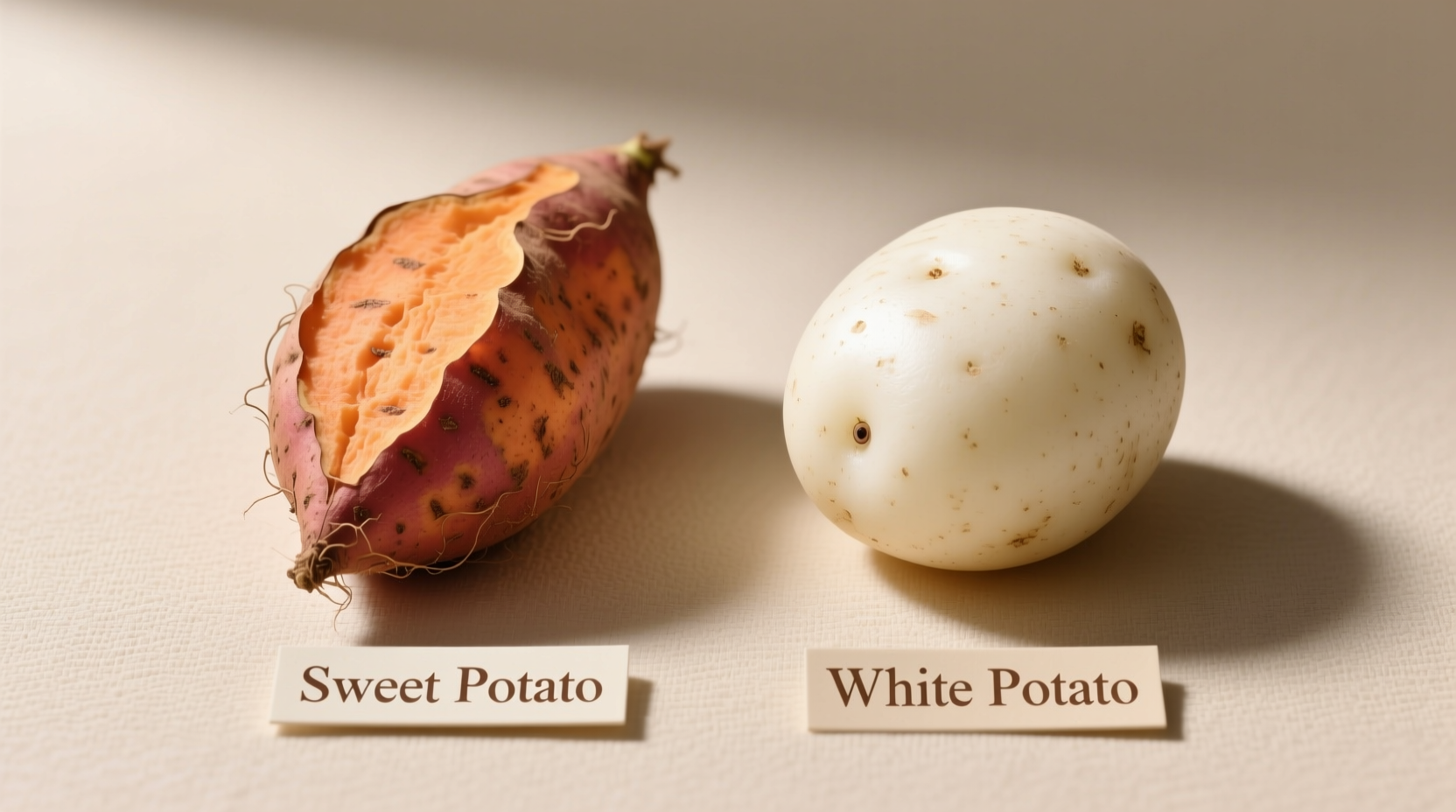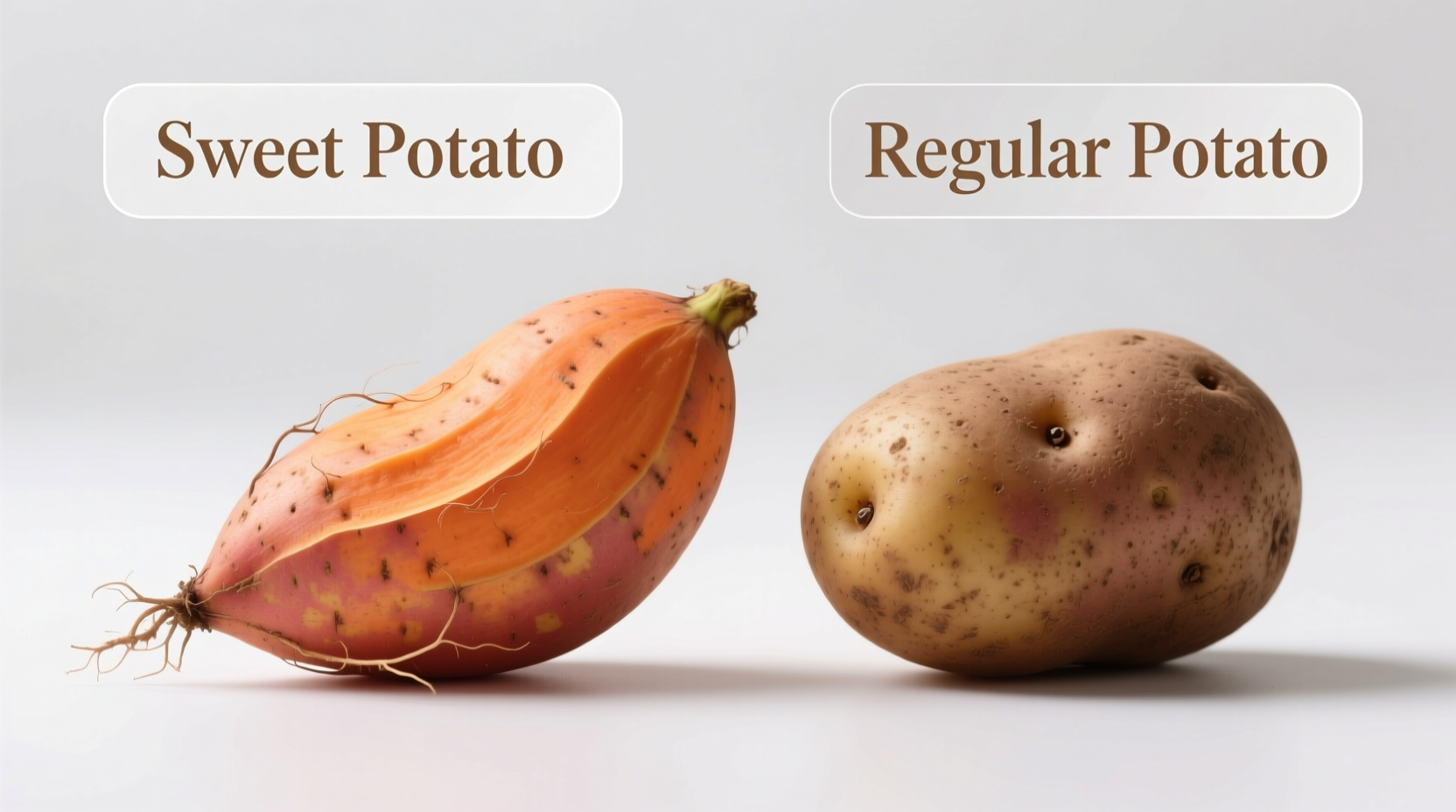Nutritional Face-Off: What's Really Different?
When comparing sweet potatoes vs regular potatoes, the nutritional differences are substantial despite their similar culinary roles. Both are nutrient-dense complex carbohydrates, but their vitamin profiles tell distinct stories.
| Nutrient (per 100g cooked) | Sweet Potato | White Potato |
|---|---|---|
| Calories | 86 | 77 |
| Carbohydrates (g) | 20.1 | 17.5 |
| Fiber (g) | 3.0 | 2.2 |
| Vitamin A (IU) | 19,218 | 2 |
| Vitamin C (mg) | 2.4 | 19.7 |
| Potassium (mg) | 337 | 421 |
| Glycemic Index | 44-61 | 72-85 |
Data sourced from USDA FoodData Central shows that sweet potatoes contain over 9,000% more vitamin A than white potatoes, making them exceptional for eye health and immune function. White potatoes, however, provide significantly more vitamin C and potassium. Both varieties offer valuable nutrients, but their nutritional strengths differ considerably.

Health Impact: Blood Sugar and Beyond
For individuals monitoring blood glucose levels, understanding the glycemic response between sweet potato vs regular potato is crucial. Research published in the American Journal of Clinical Nutrition demonstrates that sweet potatoes generally have a lower glycemic index (44-61) compared to white potatoes (72-85), meaning they cause a slower, more gradual rise in blood sugar.
This difference makes sweet potatoes often preferable for people with diabetes or prediabetes. However, preparation method dramatically affects this relationship - boiling sweet potatoes preserves more of their resistant starch compared to baking, which can increase their glycemic impact.
Culinary Performance: Texture, Flavor, and Cooking Methods
When substituting sweet potatoes for regular potatoes in recipes, understanding their different behaviors is essential for cooking success. Sweet potatoes contain more natural sugars and less starch than white potatoes, resulting in distinct cooking properties:
- Mashing: White potatoes create fluffier mash due to higher starch content
- Roasting: Sweet potatoes caramelize beautifully, developing richer flavors
- Frying: White potatoes achieve crispier results for French fries
- Boiling: Sweet potatoes hold shape better in soups and stews
The culinary chemistry behind these differences lies in their starch composition. White potatoes contain more amylopectin (a branched starch molecule), while sweet potatoes have higher amylose content, affecting how they absorb moisture and respond to heat.
When to Choose Which: Practical Decision Guide
Neither sweet potatoes nor white potatoes are universally superior - the best choice depends on your specific needs:
Choose Sweet Potatoes When:
- You need higher vitamin A for immune support or eye health
- Managing blood sugar levels is a priority
- Seeking more dietary fiber for digestive health
- Preparing dishes where natural sweetness complements other ingredients
Choose White Potatoes When:
- You need more potassium for heart health or muscle function
- Higher vitamin C intake is beneficial (especially when not peeling)
- Creating dishes requiring fluffy texture (mashed potatoes, gnocchi)
- Preparing traditional recipes where sweet potato would alter flavor profile
It's worth noting that both potatoes originated from different plant families - sweet potatoes (Convolvulaceae) are not closely related to white potatoes (Solanaceae). This botanical distinction explains many of their fundamental differences in nutrition and cooking behavior.
Common Misconceptions Clarified
Several myths persist about sweet potato vs regular potato comparisons:
- "Sweet potatoes are always healthier" - While they offer more vitamin A, white potatoes provide more potassium and vitamin C per serving
- "White potatoes cause weight gain" - Both have similar calorie counts; preparation method (butter, sour cream, frying) significantly impacts calorie density
- "Sweet potatoes don't affect blood sugar" - They still raise blood glucose, just more gradually than white potatoes
- "All sweet potatoes are orange" - Varieties include white, purple, and yellow fleshed types with different nutrient profiles
According to agricultural research from USDA, the domestication timeline reveals interesting context: white potatoes were cultivated in South America over 7,000 years ago, while sweet potatoes have been grown in Central and South America for at least 5,000 years. Both spread globally through different historical trade routes, adapting to various growing conditions worldwide.
Maximizing Nutritional Benefits
How you prepare potatoes significantly impacts their nutritional value. For both varieties:
- Leave skins on when possible - up to 50% of fiber and nutrients reside just beneath the skin
- Prefer boiling or steaming over frying to preserve nutrients and minimize added fats
- Cool cooked potatoes before eating to increase resistant starch content
- Pair with healthy fats (like olive oil) to enhance absorption of fat-soluble vitamins
Research from the National Center for Biotechnology Information shows that cooling cooked potatoes increases their resistant starch content by up to 50%, which functions as dietary fiber and has positive effects on gut health and blood sugar regulation.
Practical Takeaways for Your Kitchen
Understanding sweet potato vs regular potato differences empowers you to make informed choices based on your nutritional needs and culinary goals. Rather than viewing one as universally superior, consider them complementary ingredients in a balanced diet. Both offer valuable nutrients when prepared thoughtfully, and incorporating variety ensures you benefit from the unique nutritional profiles each provides.
Which potato has more carbohydrates, sweet potato or white potato?
Sweet potatoes contain slightly more carbohydrates per 100g (20.1g) compared to white potatoes (17.5g). However, sweet potatoes have more fiber and a lower glycemic index, meaning their carbohydrates are digested more slowly, resulting in a more gradual impact on blood sugar levels.
Can I substitute sweet potatoes for white potatoes in recipes?
You can substitute sweet potatoes for white potatoes in many recipes, but expect flavor and texture differences. Sweet potatoes have more natural sugar and less starch, so they'll be sweeter and less fluffy. For mashed potatoes, use a 1:1 substitution but reduce added sweeteners. For fries, expect sweeter, less crispy results. Some recipes like potato salad work well with either variety.
Which potato is better for weight loss?
Both potatoes can fit into a weight loss diet when prepared healthily. Sweet potatoes have slightly more calories but also more fiber, which promotes satiety. White potatoes have a higher glycemic index, which may affect hunger levels more. The preparation method matters most - boiled or roasted potatoes without added fats are better choices than fried versions of either type.
Do sweet potatoes really have more vitamin A than white potatoes?
Yes, sweet potatoes contain dramatically more vitamin A than white potatoes. A single medium sweet potato provides over 400% of the daily recommended intake of vitamin A (as beta-carotene), while white potatoes contain virtually no vitamin A. This makes sweet potatoes exceptional for eye health, immune function, and skin health.











 浙公网安备
33010002000092号
浙公网安备
33010002000092号 浙B2-20120091-4
浙B2-20120091-4